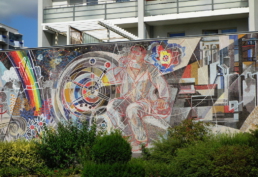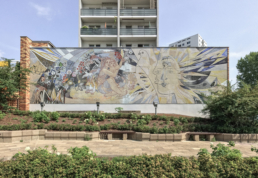As one of the most popular and eminent artists of the GDR, Walter Womacka illustrated the ideals of socialist life often in the grand and inescapable style of Kunst am Bau. Yet despite their historical significance, his works have been subject to removals (and Ikea bags) following the fall of the wall.
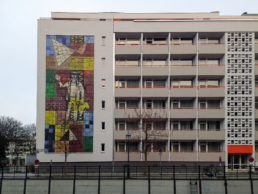
In 2010, the former premises of the GDR Ministry of Construction Berlin-Mitte was slated for demolition.
Adorning one of its exterior walls was a large mural entitled “Man, the Measure of All Things,” which had been produced by the notable Kunst am Bau artist Walter Womacka in 1968 specifically for the building. The 90 square meter mural, composed of 360 painted copper panels, had appropriately symbolized the importance of respecting the human scale in architecture.
The piece was removed plate by plate in October the same year, shortly before the building was reduced into a mountain of debris.
The copper panels were taken off the wall, lowered down and carefully placed into sturdy and large blue FRAKTA IKEA shopping bags. It was an unusual logistical solution; perhaps a direct comment on the perceived value of the work.
The packed IKEA bags were toted a couple of streets over to the corner of Sperlingsgasse and Friedrichsgracht, to be hung in their new location on the side of a GDR-era Plattenbau.
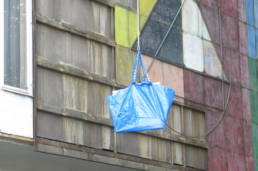
The artwork was saved from demolition by a private group dedicated to keeping the artist’s work in the public eye, founded by former members of the SED (East German Communist Party) Central Committee’s Cultural Affairs Office. The group, “Friends of Walter Womacka,” had managed to convince WBM GmbH, one of Berlin’s largest public housing corporations, to take over the artwork as an homage to Womacka, who had been their tenant since the mid-80s until he died in 2010.
The near loss and the practical yet unceremonious re-installation of a work by a revered GDR artist was a pronounced reflection of the shift in value of GDR cultural production. Created under the conditions of bondage, financed by the state and in compliance with its ideological themes, post-reunification of East and West Germany, GDR art became a historically postured moral issue. In the case of Womacka, the decline of his artistic reputation rendered his pieces into historical documents of sociological interest, a repositioning not wholly unwarranted.
An artist seeking influence
The artistic portfolio of Walter Womacka fits into the tradition of socialist realism, not only in its figurative mannerism but also in content; his subjects and inspiration were the workers, teachers and quotidien glamourized by his compositions.
A means of propaganda for social cohesion and collective harmony, his artworks, as well as those of other state-sanctioned artists, were educational and political tools, reflecting the social and political aims of former East Germany. Womacka was a pivotal aspect and proponent of bringing the population closer to art, showing in earnest the hopes for a prosperous socialist future.
Womacka was a key personality in refiguring the image of Berlin as the Capital of the German Democratic Republic. His artworks ornamented a large number of prominent buildings in Berlin and those which remain are characteristic of the visual memory of the city.
Walter Womacka was born December 22nd, 1925 in Obergeorgenthal/Horní Jiřetín, Czechia. He trained as a painter and decorator before being called up for military service in the German Wehrmacht in the last stages of World War II. His wartime experiences left him a convinced anti-fascist. After the war, he worked as an agricultural labourer after relocating to the Soviet occupation zone in Germany following the expulsion of ethnic Germans from the Sudetenland region of Czechoslovakia.
Womacka returned to his artistic studies at the College of Technology for Architecture and Visual Arts in Weimar in the same year the GDR was founded and began an eager search for young artists to promote its cause. He joined the SED in 1952 and was appointed lecturer the following year at the Kunsthochschule Berlin-Weissensee.
Womacka was very closely identified with the GDR’s image as a “Workers and Peasants’ State,” proving himself to be an ardent socialist, acquiring an influential network of supporters that included the SED party leader Walter Ulbricht.
He was mentored by Fritz Dähn, rector of the Kunsthochschule Berlin-Weissensee and a loyal SED member. By 1963, Womacka was head of the Department of Painting and by 1968 he had succeeded his mentor Dähn to become rector, a position he held until his retirement in 1988. During his tenure, he expelled more than 40 students from Weissensee for what was deemed socio-political immaturity; in other words, failure to comply with the ideological demands of state socialism.
Womacka sought to stretch his influence beyond the classroom; he was vice-president of the Verband der Bildende Künstler (Artists Union). Membership to the VBK was linked to political compliance. Members received access to work contracts awarded by the state art trade, as well as permission to participate in exhibitions, trips and conferences. Furthermore, art prizes and supplies were also linked to membership.
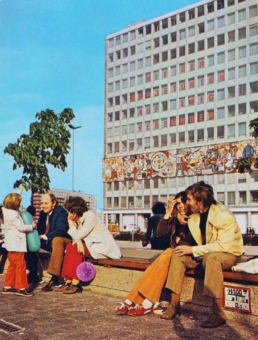
An artist of conviction
Womacka was outspoken in his unequivocal support of the Party, publicly defending the construction of the Berlin Wall as well as the highly unpopular Soviet invasion of Czechoslovakia in 1968. His support of such measures was already criticized at the time when they occurred, but it made Womacka one of the most successful artists in the GDR, reflected by his multitude of Kunst Am Bau commissions across the GDR. These imposing works were intended to educate citizens and propagate political messages, legitimizing state socialism.
The 800,000 tiles of the “Our Life” ceramic mosaic frieze on Haus des Lehrers in Berlin collectively amass an area of seven metres in height and 125 metres in length. Womacka designed and produced the work, which wraps around the building, between 1962 and 1964. It remains Europe’s largest work of art in terms of area. It depicts the dedicated labour of all socialist citizens, starting from learning as children, to honouring those who teach, sow, construct and even compete in athletic competitions, all united in their efforts to build socialism. It aestheticizes the image and lives of workers and peasants, serving as a reminder that any individual talents and success were owed to socialism.
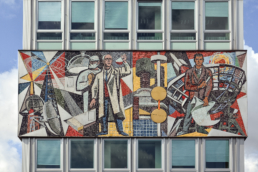
A brute gesture
German reunification brought conversations around the collaborative nature of the relationship between state artist and totalitarian regime into the open and ignited debates over the legitimate artistic merit of works created by artists for and supported by the state.
Quite suddenly, Womacka found his ideologically impregnated artworks without an audience. The conventionally socialist symbolic motifs that punctuate the vast majority of his artworks were outdated and a souvenir of a regime many wanted to forget.
As a reunified state attempted to heal over the scars of its past with an extensive program of demolition and rebuilding, many GDR era buildings were laid to waste; along with them, the Kunst am Bau which had preached the naive optimism of a future that never materialized.

In 1995, Womacka stood at the sidelines as his two-part mural “Man Designs His World” was buried under the shovels of excavators in the former ballroom of the GDR Foreign Ministry. He died shortly before his artwork “Man, the Measure of All Things,” viewed through the lens of a state mechanism, was moved in IKEA bags to its new location.
